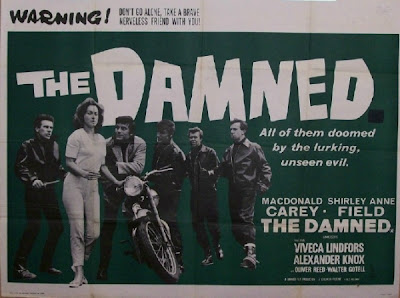(1961) Directed by Joseph Losey; Written by Evan Jones; Based on The Children of Light by H.L. Lawrence; Starring: Macdonald Carey, Shirley Anne Field, Oliver Reed, Alexander Knox and Viveca Lindfors; Available on DVD
Rating: **** ½
Hammer Films produced some of its most memorable (and profitable) movies during the late 50s through the 60s. This period represented a golden era for the small British production company, with its signature take on gothic horror. But Hammer was much more than a one trick pony, with genre examples ranging from dramas to swashbucklers to comedies and science fiction. One of the most distinctive, and sadly lesser-known Hammer films to spring from this era was These Are the Damned, a grim, thought provoking, and ultimately devastating Cold War sci-fi tale. Director Joseph Losey, who originally moved to England in the 1950s to escape the Hollywood blacklist for his political views, was attracted to the deeply cynical material. These Are the Damned was filmed in 1961, but would not see release until nearly two years later.
The film starts out seeming like one thing, and eventually becomes a different beast altogether. In the opening scene, we’re introduced to a motorcycle gang led by King, played by a young Oliver Reed. The gang’s entrance is heralded by an oddly infectious tune, “Black Leather” (another one of those songs that will be dancing around in your cranium for a week). Simon (Macdonald Carey), an American tourist, is led into an ambush by a seductive young woman named Joan (Shirley Anne Field) and subsequently beaten up by the gang. Fueled by curiosity and possibly a twinge of guilt, the woman, who’s also the gang leader’s sister, returns to Simon on his personal boat. They leave on his boat, and strike up an uneasy May-December relationship. King and his gang are never too far behind, however, watching their activities from the land like predators waiting for the kill.
(I think it’s only fair to warn you, dear reader, that it’s virtually impossible to discuss this film without some spoilers, so if you haven’t seen this yet, read on at your own risk. I promise I’ll be gentle, though.)
Some writers have cited the film’s depictions of King and his gang, as well as King’s assault on a female artist, as an obvious influence for Stanley Kubrick’s A Clockwork Orange, which came out a decade later. It’s certainly easy to draw superficial parallels between Kings’s gang and Alex and his droogs, but there are some significant differences. In These Are the Damned, King was attacking the artwork and what it symbolized, not the artist. His character is conflicted between displays of bravado and the demands of young adulthood. He clearly possessed a conscience, whereas Alex was cold-blooded through and through. Whether or not it was a major influence for A Clockwork Orange is inconsequential, as These Are the Damned stands out in its own right.
As they attempt to evade their pursuers, Simon and Joan stumble into an underground compound by the sea, populated by nine unusual children, all around 11 years of age. They quickly discover something very odd about the children, who are cold to the touch and paranoid about being under surveillance. They attend class remotely, by television, lorded over by the watchful eye of Bernard (Alexander Knox). They feel as if they’re being prepared for something, but unsure of what.
The real villain is Bernard, whose arrogance and single-minded devotion to his work prevents him from stopping to consider the ethical minefield he’s created. He doesn’t merely think, but knows that he’s right – a sentiment that echoes the Cold War paranoia of the time. Bernard is convinced that humanity is on the inevitable brink of nuclear annihilation, and these nine children represent our only hope. These future inheritors of the Earth are paradoxically dangerous to all other humans, and are doomed to stay apart from the rest of society as government prisoners until a future apocalyptic date. The discovery of their existence by outsiders does little to change the children’s situation. Now that Pandora’s Box has been opened, what is there to do but seal the box again?
This dilemma leads to a conclusion that feels like a punch to the gut. These Are the Damned does not coddle us with a pat ending, or sum everything up in a proselytizing morality speech. We’re never left off the hook for a second. It’s a reminder of how the best films can engage our minds to consider alternative viewpoints about our world, and defies stereotypes about sci-fi movies as simply mindless, unrealistic, or escapist fare. This is one of the forgotten jewels of Hammer’s crown, and deserves to be better known, taking its place among other genre classics of the 1960s.







No comments:
Post a Comment